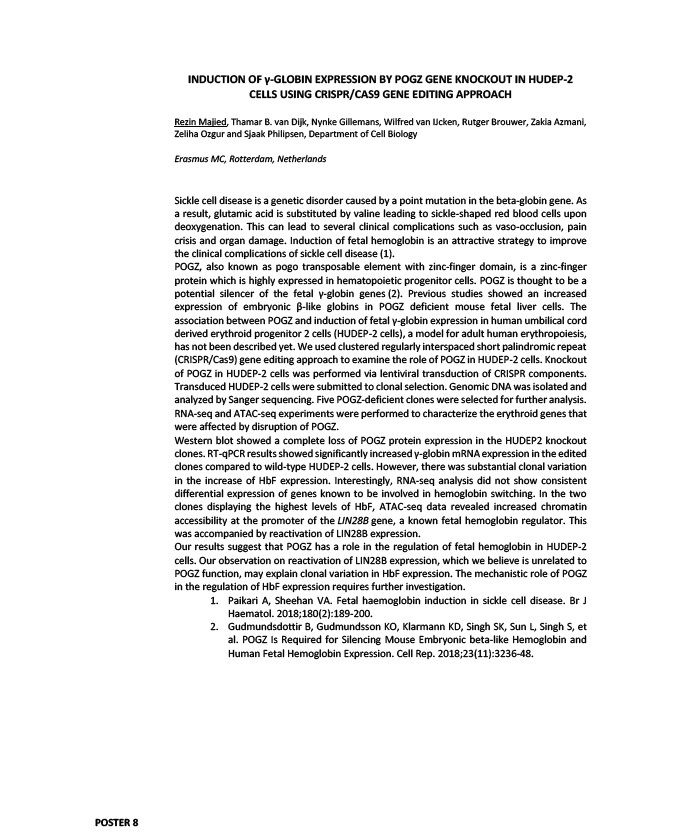
INDUCTION OF γ-GLOBIN EXPRESSION BY POGZ GENE KNOCKOUT IN HUDEP-2
CELLS USING CRISPR/CAS9 GENE EDITING APPROACH
Rezin Majied, Thamar B. van Dijk, Nynke Gillemans, Wilfred van IJcken, Rutger Brouwer, Zakia Azmani,
Zeliha Ozgur and Sjaak Philipsen, Department of Cell Biology
Erasmus MC, Rotterdam, Netherlands
Sickle cell disease is a genetic disorder caused by a point mutation in the beta-globin gene. As
a result, glutamic acid is substituted by valine leading to sickle-shaped red blood cells upon
deoxygenation. This can lead to several clinical complications such as vaso-occlusion, pain
crisis and organ damage. Induction of fetal hemoglobin is an attractive strategy to improve
the clinical complications of sickle cell disease (1).
POGZ, also known as pogo transposable element with zinc-finger domain, is a zinc-finger
protein which is highly expressed in hematopoietic progenitor cells. POGZ is thought to be a
potential silencer of the fetal γ-globin genes (2). Previous studies showed an increased
expression of embryonic β-like globins in POGZ deficient mouse fetal liver cells. The
association between POGZ and induction of fetal γ-globin expression in human umbilical cord
derived erythroid progenitor 2 cells (HUDEP-2 cells), a model for adult human erythropoiesis,
has not been described yet. We used clustered regularly interspaced short palindromic repeat
(CRISPR/Cas9) gene editing approach to examine the role of POGZ in HUDEP-2 cells. Knockout
of POGZ in HUDEP-2 cells was performed via lentiviral transduction of CRISPR components.
Transduced HUDEP-2 cells were submitted to clonal selection. Genomic DNA was isolated and
analyzed by Sanger sequencing. Five POGZ-deficient clones were selected for further analysis.
RNA-seq and ATAC-seq experiments were performed to characterize the erythroid genes that
were affected by disruption of POGZ.
Western blot showed a complete loss of POGZ protein expression in the HUDEP2 knockout
clones. RT-qPCR results showed significantly increased γ-globin mRNA expression in the edited
clones compared to wild-type HUDEP-2 cells. However, there was substantial clonal variation
in the increase of HbF expression. Interestingly, RNA-seq analysis did not show consistent
differential expression of genes known to be involved in hemoglobin switching. In the two
clones displaying the highest levels of HbF, ATAC-seq data revealed increased chromatin
accessibility at the promoter of the LIN28B gene, a known fetal hemoglobin regulator. This
was accompanied by reactivation of LIN28B expression.
Our results suggest that POGZ has a role in the regulation of fetal hemoglobin in HUDEP-2
cells. Our observation on reactivation of LIN28B expression, which we believe is unrelated to
POGZ function, may explain clonal variation in HbF expression. The mechanistic role of POGZ
in the regulation of HbF expression requires further investigation.
1. Paikari A, Sheehan VA. Fetal haemoglobin induction in sickle cell disease. Br J
Haematol. 2018;180(2):189-200.
2. Gudmundsdottir B, Gudmundsson KO, Klarmann KD, Singh SK, Sun L, Singh S, et
al. POGZ Is Required for Silencing Mouse Embryonic beta-like Hemoglobin and
Human Fetal Hemoglobin Expression. Cell Rep. 2018;23(11):3236-48.
POSTER 8